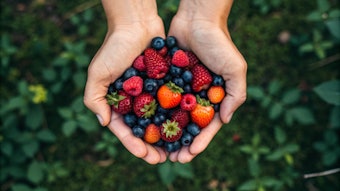Read more presentations and find photos of the event here.
While many flavor chemists focus on the “chemist” aspect of their profession, John Houtenville’s (Flavor Infusion) 2009 Flavor Symposium presentation focused on the “creative flavorist” facet of the industry. The flavorist’s job requires a litany of different knowledge bases, he said, from food and beverage science to the creative arts. “We need to spend time building,” he said, highlighting the importance of time spent at the creative bench. “That’s the exciting part of being a flavorist,” he said. It’s there where one’s skill and passion are recharged. To do so, Houtenville underscored the importance of creativity and discovery and the evaluation of raw materials.
“Flavor creation requires a knowledge base that is grounded in science and expertise and is readily available through our memory recall,” he said. In addition, he noted the importance of courage, intuition and instinct, and cited Albert Einstein’s famous dictum: “The intuitive mind is a sacred gift and the rational mind is a faithful servant. We have created a society that honors the servant and has forgotten the gift.”
“That,” said Houtenville, “leads us to the heart of flavor creation, the process of discovery.” Referencing the Merriam-Webster Dictionary definition of “discover,” he put a spotlight on concepts such as “to make known or visible” and unearthing or “bringing to light something forgotten or hidden.”
Threats to Creativity
This passion to discover new raw materials and formulation approaches, he said, is “what fuels us.” Flavor chemists become bogged down in workload challenges that sap innovation and creativity. “Often, it sneaks right up on you,” said Houtenville, “especially those of us who have to manage other flavorists. It can be very subliminal, robbing you of your opportunities and time to discover.” For instance, flavorists might be juggling as many as 15 projects at a time, depending on the size of the company. “It’s daunting to have the projects on your plate and do an excellent job on each one,” he said. “It’s hard when you’re trying to figure out, ‘How am I going to test out these new chemicals that just [landed] on my desk from our supplier. When am I really going to spend the time with them that they require?’”
Likening today’s flavorists to plate spinners, Houtenville noted that one is often asked to formulate on the fly amidst tightening deadlines. And then there are the QC demands. Fixing a problem with a new flavor can eat up time—it’s obviously a priority that must be resolved to resume production. “We’re excited about first-time runs because that means our flavor is being launched, scaled up,” he said. “Sometimes you have a scale-up team to rely on, sometimes you don’t.” Smaller companies require one to wear more hats. “Dealing with first-time productions, can be exciting on one hand; but on the other hand, stressful and time consuming to make sure the manufactured flavor replicates your lab scale creation. The pressure is on you to have all the solutions to the inevitable issues that come up!” All of this can come upon you in addition to ISO and regulatory compliance, shipping issues, marketing, company goals and department objectives, personal recordkeeping, intra-company meetings, and intra-office politics.
Henry Ford’s answer to procrastination was: “You can't build a reputation on what you are going to do.” Flavorists facing too many tasks over an extended period of time may fall into discouragement which can lead to sluggishness and procrastination; burn-out. Houtenville added, “The bench can easily become too full.” This complacency due to burnout can be a major pitfall for any busy flavorist. The issue isn’t always too much work; sometimes procrastination is born from disappointment. “Let’s say you lose a project,” said Houtenville. “You’re working on a project for a month, sending samples in, visiting the customer, and next thing you know—you’re out!” And in many cases the flavorist may never truly know why they lost. Was it political? Did the flavor come in a penny more per pound than the competition? “When you pour your all into it, it can get very discouraging,” Houtenville acknowledged.
One can lose heart when faced with several of these issues at once. At such times, Houtenville said, “Getting back to the bench becomes all the more critical. That’s one of the solutions to pop yourself out of it.”
Boosting Creativity
Most of what you learn is from somebody else, goes the old saying. In flavors, says Houtenville, “Teachability is critical. Are you willing to learn?” Resistance to this can manifest itself as defensiveness when challenged. “Especially when someone in your tasting session is overly enthusiastic to criticize your flavor efforts! Honestly, it distills down to our fear of what others think and our fear of failure,” he explained. “Those imbedded fears keep us from being teachable. Teachable moments often come from the most uncomfortable and humbling times. We can learn so much during those times if we are willing.”
Following the lead of John Maxwell’s Talent is Never Enough, Houtenville said, “We all have talent. Some of us are excellent flavorists, some of us are pretty good flavorists, some of us are learning to be great flavorists; wherever you’re at, talent isn’t enough. Integrity, courage, innovation and a positive attitude are essential as well.
He encouraged symposium attendees to renew their desire to discover. “It takes time and effort, like anything worthwhile,” he said. “Spend more time in the produce aisle. Smell things, taste them. Take notes.” This latter point is critical. Houtenville explained that he once tasted something that he hated, but which had a unique leathery note. If he’d written his impressions down he would be able to recall and pursued that train of thought at later date, perhaps it would have lead to a creative breakthrough. Instead, he said, the inspiration was lost. He added that flavorists should be repetitious. “Go back to the basics,” Houtenville said. “Renew your flavor ingredient cards or your personal, ingredient database” (He still has cards from 24 or more years ago.) And, he said, “Carve out the time to discover. Make it a habit. Be intentional, really work. On a weekly basis, get to the bench. Set aside everything; take a couple of hours a week and begin to “muscle-in” extra time. If you can get to the bench daily, that would be great. Be motivated to stay with it no matter what. Push through the dry spells. Make your tasting time routine. You need some focus time.” Houtenville encouraged managers to make such bench time a part of their flavorist’s annual objectives, as part of their annual review.
Know Your Materials
Ingredient knowledge is key, said Houtenville. Citing Frank Fischetti’s taste categories, he discussed character impact ingredients (materials that contribute the character component of a flavor such as benzaldehyde in cherry), contributory raw materials (those necessary to produce the desired flavor, but not essential to it; those that do not taste of the named flavor in and of themselves) and differential ingredients (those that are unique and offer complexity and signature; mustard oil in tropical flavors, for instance). Flavorists should also explore synergy among materials, combinations of ingredients in which 1 +1 = 3. These synergistic effects, Houtenville said, can be found by spending bench time. Finally, flavorists should be well versed in stability/solubility, cross-use, synthetic vs natural counterparts (what are the differences?), suppliers and availability, preparation and evaluation and dosage (ppm, not %).










